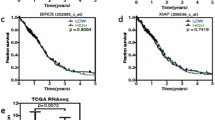Abstract
Several protocols for the adjuvant treatment of glioblastoma multiforme (GBM) are currently being evaluated. In this context, little is known about the influence of radiochemotherapy on apoptosis and the expression of apoptosis-related proteins in vivo.
We have analyzed the incidence of apoptosis using in situ nick translation (ISNT) and expression of Ki-67 (MIB-1), p53 (DO-1 and DO-7), Bcl-2 and transglutaminase II (TGase II) by immunohistochemistry in 41 patients with GBM and their matched relapses. Sixteen patients received radiochemotherapy, 18 irradiation and 7 no treatment. Radiochemotherapy resulted in an increase in Bcl-2+ cells (p=0.013). Irradiation caused the reduction of MIB-1+ (p=0.0015), DO-7+ (p=0.0043) and the increase of Bcl-2+ cells (p=0.016). We calculated a positive correlation between high TGase II scores in patients preceding radiochemotherapy (p=0.0186) and no treatment (p=0.0158), low ISNT scores (p=0.0018) and high DO-1 scores (p=0.0233) in patients preceding irradiation and short time to progression.
These data show that distinct postsurgical radiochemotherapy protocols differentially alter cellular proliferation and expression of p53 and Bcl-2 in GBM relapses. Furthermore, we show that ISNT, DO-1 and TGase II labeling scores are therapy-specific predictors of time to progression in GBM patients.
Similar content being viewed by others
References
Berkman RA, Clark WC, Saxena A, Robertson JT, Oldfield EH, Ali IU: Clonal composition of glioblastoma multiforme. J Neurosurg 77: 432-437, 1992
James CD, Carlbom E, Dumanski JP, Hansen M, Nordenskjold M, Collins VP, Cavenee WK: Clonal genomic alterations in glioma malignancy stages. Cancer Res 48: 5546-5551, 1988
Hockenbery D, Nunez G, Milliman C, Schreiber RD, Korsmeyer SJ: Bcl-2 is an inner mitochondrial membrane protein that blocks programmed cell death. Nature 348: 334-336, 1990
Sidransky D, Mikkelsen T, Schwechheimer K, Rosenblum ML, Cavanee W, Vogelstein B: Clonal expansion of p53 mutant cells is associated with brain tumour progression. Nature 355: 846-847, 1992
Kuerbitz SJ, Plunkett BS, Walsh WV, Kastan MB: Wildtype p53 is a cell cycle checkpoint determinant following irradiation. Proc Natl Acad Sci USA 89: 7491-7495, 1992
Livingstone LR, White A, Sprouse J, Livanos E, Jacks T, Tlsty TD: Altered cell cycle arrest and gene amplification potential accompany loss of wild-type p53. Cell 70: 923-935, 1992
Fisher TC, Milner AE, Gregory CD, Jackman AL, Aherne GW, Hartley JA, Dive C, Hickman JA: Bcl-2 modulation of apoptosis is induced by anticancer drugs: resistance to thymidylate stress is independent of classical resistance pathways. Cancer Res 53: 3321-3326, 1993
Iwaki T, Miyazono M, Hitosumatsu T, Tateishi J: An immunohistochemical study of tissue transglutaminase in gliomas with reference to their cell dying processes. Am J Pathol 145: 776-778, 1994
Gold R, Schmied M, Rothe G, Zischler H, Breitschopf H, Wekerle H, Lassmann H: Detection of DNA fragmentation in apoptosis: application of in situ nick-translation to cell culture systems and tissue sections. J Histochem Cytochem 41: 1023-1030, 1993
Hsu SM, Raine L, Fanger H: Use of avidin-biotin-peroxidase complex (ABC) in immunoperoxidase techniques: a comparison between ABC and unlabeled antibody (PAP) procedures. J Histochem Cytochem 29: 577-580, 1981
Lan HY, Mu W, Ng YY, Nikolic-Paterson DJ, Atkins RC: A simple, reliable, and sensitive method for nonradioactive in situ hybridization: use of microwave heating to improve hybridization efficiency and preserve tissue morphology. J Histochem Cytochem 44: 281-287, 1996
Deininger MH, Meyermann R: Multiple eptiope labeling by the exclusive use of alkaline phosphatase conjugates in immunohistochemistry. Histochem Cell Biol 110: 425-430, 1998
Figge C, Reifenberger G, Vogeley KT, Messing M, Roosen N, Wechsler W: Immunohistochemical demonstration of proliferating cell nuclear antigen in glioblastomas: pronounced heterogeneity and lack of prognostic significance. J Cancer Res Clin Oncol 118: 289-295, 1992
Wikstrand CJ, Grahmann FC, McComb RD, Bigner DD: Antigenic heterogeneity of human anaplastic gliomas and glioma-derived cell lines defined by monoclonal antibodies. J Neuropathol Exp Neurol 44: 229-241, 1985
Schiffer D, Cavalla P, Migheli A, Chio A, Giordana MT, Marino S, Attanasio A: Apoptosis and cell proliferation in human neuroepithelial tumors. Neurosci Lett 195: 81-84, 1995
Rainov NG, Dobberstein KU, Bahn H, Holzhausen HJ, Lautenschlager C, Heidecke V, Burkert W: Prognostic factors in malignant glioma: influence of the overexpression of oncogene and tumor-suppressor gene products on survival. J Neuro-Oncol 35: 13-28, 1997
Soini Y, Niemela A, Kamel D, Herva R, Bloigu R, Paakko P, Vahakangas K: p53 immunohistochemical positivity as a prognostic marker in intracranial tumours. APMIS 102: 786-792, 1994
Rieger L, Weller M, Bornemann A, Schabet M, Dichgans J, Meyermann R: Bcl-2 family protein expression in human malignant glioma: a clinical-pathological correlative study. J Neurol Sci 155: 68-75, 1998
Weller M, Frei K, Groscurth P, Krammer PH, Yonekawa Y, Fontana A: Anti-Fas/APO-1 antibody-mediated apoptosis of cultured human glioma cells. Induction and modulation of sensitivity by cytokines. J Clin Invest 94: 954-964, 1994
Yin XM, Oltvai ZN, Korsmeyer SJ: BH1 and BH2 domains of Bcl-2 are required for inhibition of apoptosis and heterodimerization with Bax. Nature 369: 321-323, 1994
Trepel M, Groscurth P, Malipiero U, Gulbins E, Dichgans J, Weller M: Chemosensitivity of human malignant glioma: modulation by p53 gene transfer. J Neuro-Oncol 39: 19-32, 1998
Montenarh M: Biochemical properties of the growth suppressor/ oncoprotein p53. Oncogene 7: 1673-1680, 1992
Tada M, Matsumoto R, Iggo RD, Onimaru R, Shirato H, Sawamura Y, Shinohe Y: Selective sensitivity to radiation of cerebral glioblastomas harboring p53 mutations. Cancer Res 58: 1793-1797, 1998
Haas-Kogan DA, Yount G, Haas M, Levi D, Kogan SS, Hu L, Vidair C, Deen DF, Dewey WC, Israel MA: p53-dependent G1 arrest and p53-independent apoptosis influence the radiobiologic response of glioblastoma. Int J Radiat Oncol Biol Phys 36: 95-103, 1996
Author information
Authors and Affiliations
Rights and permissions
About this article
Cite this article
Deininger, M.H., Grote, E., Wickboldt, J. et al. Distinct Radiochemotherapy Protocols Differentially Influence Cellular Proliferation and Expression of p53 and Bcl-2 in Glioblastoma Multiforme Relapses In Vivo. J Neurooncol 48, 121–129 (2000). https://doi.org/10.1023/A:1006462618800
Issue Date:
DOI: https://doi.org/10.1023/A:1006462618800




